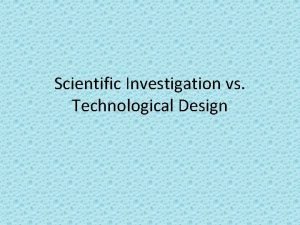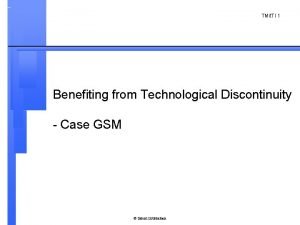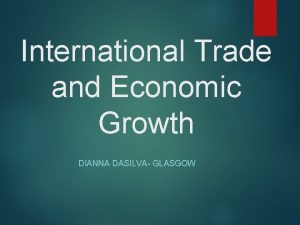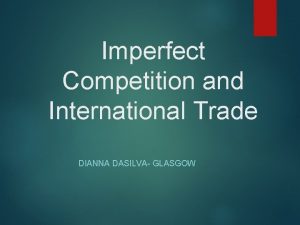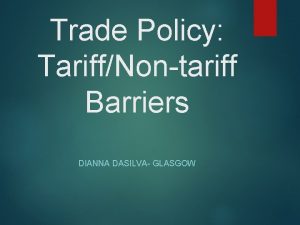TECHNOLOGICAL GAP AND PRODUCT CYCLE MODELS DIANNA DASILVA
















- Slides: 16

TECHNOLOGICAL GAP AND PRODUCT CYCLE MODELS DIANNA DASILVA- GLASGOW

Introduction Technological gap model Product cycle model International Trade Theory. ECN 4202, 2016/2017 2 6/14/2021 Outline

This assumption is not valid as nations often do use different technologies. Where nation’s have access to different production techniques factor use may not be based on factor abundance. International Trade Theory. ECN 4202, 2016/2017 Relaxing Assumption No. 2 - Both nations use the same technology in production 3 6/14/2021 INTRODUCTION

INTRODUCTION is based on static comparative advantage. However, technological differences over time can lead to dynamic comparative advantage. International Trade Theory- ECN 4202, 2016/2017 6/14/2021 Assumption 4

Key Features: Proponent: Posner (1961) Countries acquire comparative advantage based on their capacity to innovate, that is, to introduce new products and processes into the production of goods and services. Trade among industrialized counties is based on innovation e. g. smart phone in the US (IBM Simon (1992)) 5 International Trade Theory- ECN 4202, 2016/2017 6/14/2021 TECHNOLOGICAL GAP MODEL

the innovating country is protected by patents and copyrights which allows them to monopolize world trade in the commodity. In fact, patents and copyrights, which usually last about 25 years provide an incentive for innovation as they allow companies to recuperate the costs of research and development and enjoy the profits of their innovation. 6 International Trade Theory- ECN 4202, 2016/2017 6/14/2021 TECHNOLOGICAL GAP MODEL Comparative advantage is acquired because

given out mainly in developed countries as the cost to consumers in developing countries of copyrighted commodities is too onerous. Hence, trade in new products and process tend to characterize trade among industrialized countries. 7 International Trade Theory- ECN 4202, 2016/2017 6/14/2021 TECHNOLOGICAL GAP MODEL However, patents and copyrights tend to be

Countries such as Japan and the Newly Industrializing Countries (NICs) of Asia, have developed their economies by producing goods that were initially produced by developed countries such as radios and computers. The technological gap between developed and developing countries has narrowed. 8 International Trade Theory- ECN 4202, 2016/2017 6/14/2021 TECHNOLOGICAL GAP MODEL

Shortcomings: Does not explain the size of the technological gap Does not explore reason technological gaps arise and how they could be eliminated. 9 International Trade Theory- ECN 4202, 2016/2017 6/14/2021 TECHNOLOGICAL GAP MODEL

PRODUCT CYCLE MODEL Features: Extension of the technological gap model Proponent: Vernon (1966) Products pass through phases of development that can see comparative advantage shifting based on ability to take advantage of factor endowments. International Trade Theory- ECN 4202, 2016/2017 6/14/2021 Key 10

PRODUCT CYCLE MODEL New 1: Innovation products developed often require highly skilled labour to produce. Hence, the innovating country will initially have the comparative advantage in the production of the commodity. International Trade Theory- ECN 4202, 2016/2017 6/14/2021 Stage 11

PRODUCT CYCLE MODEL 2: Standardization With maturity the product becomes standardized and can therefore be produced by mass production techniques and less skilled labour. Comparative advantage can therefore shift to countries more endowed with low-skilled labour. this shift could be facilitated by the innovating country through FDI. International Trade Theory- ECN 4202, 2016/2017 6/14/2021 Stage 12

PRODUCT CYCLE MODEL 1. There are more opportunities for capital-intensive (labour -saving) innovations in developed countries (e. g. abundance of R&D). 2. The development of such new products require proximity to markets so as to benefit from consumer feedback in product modification 3. Need for service provision in advanced economies. International Trade Theory- ECN 4202, 2016/2017 6/14/2021 Innovation is usually led by developed countries and involves a capital- intensive, high-skilled labour or R&D intensive commodity because: 13

PRODUCT CYCLE MODEL the most highly industrialized economies will export non-standardized products embodying new and more advanced technologies and import products embodying old and less advanced technologies. Example: US and Japanese radio manufactures. The US invented the vacuum and transistor technologies both of which were imitated by Japan. The US has recently came up with printed circuits technology International Trade Theory- ECN 4202, 2016/2017 6/14/2021 Therefore: 14

illustration Stage 1 - the product is consumed only in the innovating country Stage 2 - product is perfected in the importing country and increases to satisfy growing domestic and international demand Stage 3 - the product becomes standardized and the imitating country starts producing for the domestic market Stage 4 - the imitating country starts to undersell the innovating country in third markets Stage 5 - the imitating country starts to undersell the innovating country in its own market See Fig International Trade Theory- ECN 4202, 2016/2017 6/14/2021 15

6/14/2021 Salvatore (2007) , Chapter 6 16 Further reading International Trade Theory. ECN 4202, 2016/2017
 Technological gap model
Technological gap model Dianna abdala
Dianna abdala Wiggles exhibition
Wiggles exhibition Dianna kokoszka net worth
Dianna kokoszka net worth Product life cycle kotler
Product life cycle kotler Difference between model and semi modals
Difference between model and semi modals Qo'shma gaplar
Qo'shma gaplar Compiler bridges the semantic gap between which domains?
Compiler bridges the semantic gap between which domains? Technological design and scientific investigation
Technological design and scientific investigation Relationship between total average and marginal product
Relationship between total average and marginal product What is product mix in marketing
What is product mix in marketing Components of organizational feasibility analysis
Components of organizational feasibility analysis Distinguish between gdp and gnp
Distinguish between gdp and gnp Visvesvaraya technological university nagpur
Visvesvaraya technological university nagpur Technological discontinuity definition
Technological discontinuity definition Technological risk definition
Technological risk definition What is technological modelling
What is technological modelling








